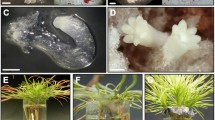Abstract
Using degenerate PCR primers that target evolutionarily conserved sequences in pal genes, we show that in the gymnosperm, Pinus banksiana, phenylalanine ammonia-lyase (PAL) is encoded by a multigene family of at least eight to ten loci. Five classes of pal sequence were easily distinguished among 28 clones sequenced from the products of PCR amplification of haploid genomic DNA. The dominant sequence from each class was named, yielding pal1 to pal5 loci. These genes shared 68.8% to 94.0% nucleotide identity over the 366 bp region compared. All of pal1 to pal5 were expressed in cell suspension cultures treated with a fungal elicitor and all but pal3 were expressed in differentiating xylem tissue of a mature tree. Only pal1 was expressed in unelicited cell cultures. While these P. banksiana genes are quite divergent, they are still more similar to each other than to any angiosperm pal gene cloned to date. For its roles in development and defense, PAL production in P. banksiana is coordinated from a large, diverse multigene family. We discuss evidence suggesting that other pines have similar pal gene family structures.
Similar content being viewed by others
References
Appert C, Logemann E, Hahlbrock K, Schmid J, Amrhein N: Structural and catalytic properties of the four phenylalanine ammonialyase isoenzymes from parsley (Petroselinum crispum Nym.). Eur J Biochem 225: 491–499 (1994).
Ausubel FM, Brent R, Kingston RE, Moore DD, Seidman JG, Smith JA, Struhl K: Current Protocols in Molecular Biology. John Wiley, New York (1995).
Bradley RD, Hillis DM: Recombinant DNA sequences generated by PCR amplification. Mol Biol Evol 14: 592–593 (1997).
Campbell MM, Ellis BE: Fungal elicitormediated responses in pine cell cultures I. Induction of phenylpropanoid metabolism. Planta 186: 409–417 (1992).
Campbell MM, Ellis BE: Fungal elicitormediated responses in pine cell cultures III. Purification and characterization of phenylalanine ammonialyase. Plant Physiol 98: 62–70 (1992).
Chaw SM, Zharkikh A, Sung HM, Lau TC, Li WH: Molecular phylogeny of extant gymnosperms and seed plant evolution: analysis of nuclear 18S rRNA sequences. Mol Biol Evol 14: 56–68 (1997).
Deshpande AS, Surendranathan KK, Nair PM: The phenylpropanoid pathway enzymes in Solanum tuberosum exist as a multienzyme complex. Indian J Biochem Biophys 30: 36–41 (1993).
Diallinas G, Kanellis AK: A phenylalanine ammonialyase gene from melon fruit: cDNA cloning, sequence and expression in response to development and wounding. Plant Mol Biol 26: 473–479 (1994).
Dixon RA, Paiva NL: Stressinduced phenylpropanoid metabolism. Plant Cell 7: 1085–1097 (1995).
Hahlbrock K, Scheel D: Physiology and molecular biology of phenylpropanoid metabolism. Annu Rev Plant Physiol Plant Mol Biol 40: 347–369 (1989).
Hahlbrock K, Scheel D, Logemann E, Nürnberger T, Parniske M, Reinold S, Sacks WR, Schmelzer E: Oligopeptide elicitormediated defense gene activation in cultured parsley cells. Proc Natl Acad Sci USA 92: 4150–4157 (1995).
Lam ML: Phenylalanine ammonialyase (EC 4.3.1.5) from Pinus banksiana: partial cDNA cloning and effect of exogenously supplied transcinnamic acid on elicitorinducible expression. M.Sc. thesis, University of British Columbia (1995).
Lawton MA, Lamb CJ: Transcriptional activation of plant defense genes by fungal elicitor, wounding, and infection. Mol Cell Biol 7: 335–341.
Lewisohn E, Steele CL, Croteau R: Simple isolation of functional RNA from woody stems of gymnosperms. Plant Mol Biol Rep 12: 20–25 (1994).
Liang X, Dron M, Cramer CL, Dixon RA, Lamb CJ: Differential regulation of phenylalanine ammonialyase genes during plant development and by environmental cues. J Biol Chem 264: 14486–14492 (1989).
Logemann E, Parniske M, Hahlbrock K: Modes of expression and common structural features of the complete phenylalanine ammonialyase gene family in parsley. Proc Natl Acad Sci USA 92: 5905–5909 (1995).
Lois R, Dietrich A, Hahlbrock K, Schulz W: A phenylalanine ammonialyase gene from parsley: structure, regulation and identification of elicitor and light responsive cisacting elements. EMBO J 8: 1641–1648 (1989).
Ni W, Fahrendorf T, Ballance GM, Lamb CJ, Dixon RA: Stress responses in alfalfa (Medicago sativa L.). XX. Transcriptional activation of phenylpropanoid pathway genes in elicitorinduced cell suspension cultures. Plant Mol Biol 30: 427–438 (1996).
Parsons TJ, Gradshaw HD, Gordon MP: Systemic accumulation of specific mRNAs in response to wounding in poplar trees. Proc Natl Acad Sci USA 86: 7895–7899 (1989).
Phillips RL, Kaeppler SM, Olhoft P: Genetic instability of plant tissue cultures: breakdown of normal controls. Proc Natl Acad Sci USA 91: 5222–5226 (1994).
Saiki RK, Gelfand DH, Stoffel S, Scharf SJ, Higuchi R, Horn GT, Mullis KB, Erlich HA: Primerdirected enzymatic amplification ofDNAwith a thermostableDNApolymerase. Science 239: 487–491 (1988).
Sambrook J, Fritsch EF, Maniatis T: Molecular Cloning: A Laboratory Manual. Cold Spring Harbor Laboratory Press, Cold Spring Harbor, NY (1989).
Savard L, Li P, Strauss SH, Chase MW, Michaud M, Bousquet J: Chloroplast and nuclear gene sequences indicate Late Pennsylvanian time for the last common ancestor of extant seed plants. Proc Natl Acad Sci USA 91: 5163–5167 (1994).
Schuster B, Retey J: Serine-202 is the putative precursor of the active site dehydroalanine of phenylalanine ammonialyase. Sitedirected mutagenesis studies on the enzyme from parsley (Petroselinum crispum L.). FEBS Lett 349: 252–254 (1994).
Sederoff R, Campbell M, O'Malley D, Whetten R: Genetic regulation of lignin biosynthesis and the potential modification of wood by genetic engineering in loblolly pine. In: Ellis BE, Kuroki G, Stafford HA (eds) Genetic Engineering of Plant Secondary Metabolism, pp. 313–355. Plenum Press, NewYork (1994).
Subramaniam R, Reinold S, Molitor EK, Douglas CJ: Structure, inheritance, and expression of hybrid poplar (Populus trichocarpa 24-1 Populus deltoides) phenylalanine ammonialyase genes. Plant Physiol 102: 71–83 (1993).
Tulsieram LK, Glaubitz JC, Kiss G, Carlson JE: Single tree genetic linkage mapping in conifers using haploid DNA from megagametophytes. Bio/technology 10: 686–690 (1992).
Wanner LA, Guoqing L, Ware D, Somssich IE, Davis KR: The phenylalanine ammonialyase gene family in Arabidopsis thaliana. Plant Mol Biol 27: 327–338 (1995).
Whetten RW, Sederoff RR: Phenylalanine ammonialyase from loblolly pine: purification of the enzyme and isolation of complementary DNA clones. Plant Physiol 98: 380–386 (1992).
Author information
Authors and Affiliations
Rights and permissions
About this article
Cite this article
Butland, S.L., Chow, M.L. & Ellis, B.E. A diverse family of phenylalanine ammonia-lyase genes expressed in pine trees and cell cultures. Plant Mol Biol 37, 15–24 (1998). https://doi.org/10.1023/A:1005941228246
Issue Date:
DOI: https://doi.org/10.1023/A:1005941228246




